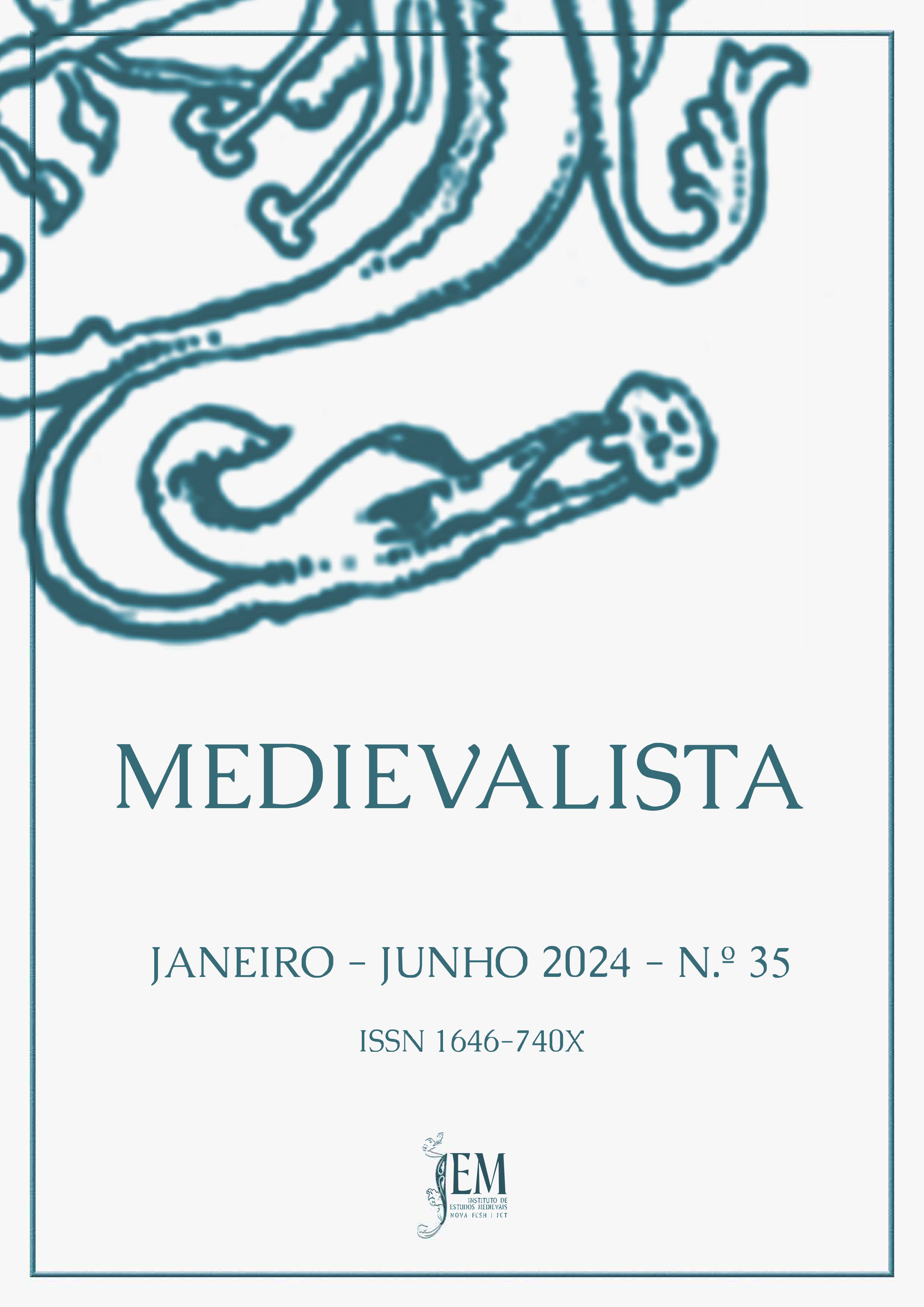Babuinare: apes in 14th century portuguese marginalia
DOI:
https://doi.org/10.4000/medievalista.7741Keywords:
iconography, marginalia, Portugal, apes, 14th centuryAbstract
Commonly known for their prolix and heterodox nature, the margins of medieval art present us a vast array of figures, themes and representational strategies that deserve to be questioned and learnt about. Created to fill voids, to dynamise surfaces and spatial relations, to comment on and amplify the effects anticipated for the centre, they were also invested with playful, prophylactic and apotropaic functions, so important in medieval culture but still so little studied (and so difficult to study) in Portugal.
Among the various protagonists of these margins of medieval art, and particularly from the 13th century on, apes stand out as a satirical and moralising simile of mankind, and, therefore, as the main actors of a topsy turvy world that finds its natural place on the margins. Attesting to this close relationship, the first known medieval designation for what we now call marginalia, comes from the term babewyn, or baboon, summoning the generality of the simian species and behaviours then known.
Based on this affinity, we will seek to identify and, whenever possible, interpret some of the most significant representations of monkeys in medieval marginalia in Portugal during the 14th century, of which two unpublished case studies stand out.
Referências bibliográficas
Fontes
Fontes manuscritas
Porto, Biblioteca Pública Municipal do Porto, MS Santa Cruz 24.
Porto, Biblioteca Pública Municipal do Porto, Ms. 623.
The Aberdeen Bestiary - MS 24 [Em linha] Aberdeen: University of Aberdeen [Consultado a10 Junho 2023]. Disponível em https:// www.abdn.ac.uk/bestiary/translat/12v.hti
Fontes impressas
BLUTEAU, Raphael – Vocabulario Portuguez & Latino. Vol. 2. Coimbra: Colégio da Companhia de Jesus, 1728.
CHAUCER, Geoffrey – The House of Fame. Ed. Walter Skeat. The Complete Works of Geoffrey Chaucer. London: Oxford University Press, 1937.
Cleanness. Ed. Richard Morris. In Early English Alliterative Poems in the West-Midland Dialect of the Fourteenth Century. London: Trübner & Co., 1864. pp. 38-91.
DE LA HALLE, Adam; GUIART, Guillaume - Branche des royaux lignages: chronique métrique de Guillaume Guiart. Ed. J.-A. Bouchon. Paris: Verdière, 1828.
DU CANGE, et al. – Glossarium mediae et infimae latinitatis [Em linha]. éd. augm. Niort : L. Favre, 1883‑1887 [consultado a 10 Junho 2023]. Disponível em http://ducange.enc.sorbonne.fr/
FIAMMA, Galvano – De rebus gestis ab Azone, Luchino et Johanne Vicecomitibus ab anno MCCCXVIIII usque annum MCCCXLII. Ed. C. Castiglioni. Rerum Italicarum Scriptores. Series II, Tomo XII, 4. Bologna: Nicola Zanichelli, 1938.
LYDGATE, John – Troy Book. Ed. Henry Bergen. Lydgate’s Troy Book. I. London: Trübner & Co., 1906.
Promptorium Parvulorum sive Clericorum. Ed. Albert Way. London: Camden Society, 1838.
ROLLAND, Francisco – Adagios, Proverbios, Rifãos e Anexis da Lingua Portuguesa. Lisboa: Typographia Rollandiana, 1780.
TIREL, Guillaume – Le viandier de Guillaume Tirel, dit Taillevent. Ed. Jérôme Pichon, Georges Vicaire. Paris: Techner, 1892.
VICENTE, Gil – Auto dos Físicos. Ed. Centro de Estudos de Teatro. Teatro de Autores Portugueses do Séc. XVI - Base de dados textual [Em linha]. Lisboa: Centro de Estudos de Teatro, 2010. [Consultado a 06 Junho 2023]. Disponível em http:// www.cet-e-quinhentos.com/obras
Estudos
AFONSO, Luís Urbano – O ser e o tempo. As idades do Homem no gótico português. Casal de Cambra: Caleidoscópio, 2003.
APOSTOLOS-CAPPADONA, Diane – “Discerning the Hand-of-Fatima: An Iconological Investigation of the Role of Gender in Religious Art”. In SONBOL, Amira El Azhary (Ed.) - Beyond the Exotic: Women’s Histories in Islamic Societies. New York: Syracuse University Press, 2005, pp. 347-361.
ANTUNES, Joana – O Limite da Margem na Arte em Portugal (sécs. XIV-XVI). Coimbra: Universidade de Coimbra, 2016. Dissertação de Doutoramento.
ANTUNES, Joana – “Sem medo nem vergonha. Imagens insólitas à margem da escultura medieval”. Kairós. Boletim do Centro de Estudos em Arqueologia, Artes e Ciências do Património 10 (2021), pp. 7-25.
ARNAUT, Salvador Dias – A Crise Nacional dos Fins do Século XIV. Coimbra: FLUC-Instituto de Estudos Históricos Dr. António de Vasconcelos, 1960.
BAKHTIN, Mikhail – Rabelais and His World. Bloomington: Indiana University Press, 1984.
BARTHOLEYNS, Gil; DITTMAR, Pierre-Olivier; JOLIVET, Vincent – Image et Transgression au Moyen Âge. Paris: PUF, 2008.
BOUCHERON, Patrick – Le pouvoir de bâtir. Urbanisme et politique édilitaire à Milan (XIVe-XVe siècles). Roma: École Française de Rome, 1998.
BRAGA, Isabel Drumond; BRAGA, Paulo Drumond – Animais e Companhia na História de Portugal. Lisboa: Círculo de Leitores, 2015.
BUQUET, Thierry – “Preventing ‘Monkey Business’. Fettered Apes in the Middle Ages”. Medieval Animal Data Network [Em linha] (2013) [Consultado a 12 Junho 2023]. Disponível em http://mad.hypotheses.org/37
CAMILLE, Michael – “Play, Piety and Perversity in Medieval Marginal Manuscript Illumination”. In KRÖLL, Katrin; STEGER, Hugo (eds.) – Mein ganzer Körper ist Gesicht: Groteske Darstellungen in der europäischen Kunst und Literatur des Mittelalters. Freiburg: Rombach, 1994, pp. 171-192.
CAMPS, Daniel Rico – “Ridiculous Voices in Medieval Art”. In BONET, Francesca (ed.) – Repensar el sombrío Medioevo. Kassel: Reichenberger, 2014, pp. 25-44.
CLASSEN, Albrecht (ed.) – Laughter in the Middle Ages and Early Modern Times: Epistemology of a Fundamental Human Behavior, its Meaning, and Consequences. Berlin & New York: Walter de Gruyter GmbH, 2010.
CLARK, Stuart – Thinking with Demons. Oxford: Oxford University Press, 1999.
FERNANDES, Carla Varela – A Imagem de um Rei. Análise do Túmulo de D. Fernando I. Lisboa: Museu Arqueológico do Carmo - Associação dos Arqueólogos Portugueses, 2009.
FREITAG, Barbara – Sheela-na-gigs: Unravelling an Enigma. London & New York: Routledge, 2004.
GANDRA, Manuel J. – Filosofia Hermética. As Tentações de Bosch ou o Eterno Retorno. Lisboa: Museu Nacional de Arte Antiga, 1994.
GIMBEL, Lena Mackenzie – Bawdy badges and the Black Death: late medieval apotropaic devices against the spread of the plague. Louisville: Faculty of the College of Arts and Sciences of the University of Louisville, 2012. Dissertação de Mestrado.
GOMES, Rita Costa – D. Fernando. Lisboa: Círculo de Leitores, 2005.
GOMES, Saul António – Vésperas Batalhinas. Estudos de História e Arte. Leiria: Edições Magno, 1997.
GÓMEZ MARTÍNEZ, Susana (Coord.) – Os Signos do Quotidiano. Gestos, Marcas e Símbolos no Al-Ândalus. Mértola: Campo Arqueológico de Mértola - CEAUCP, 2011
JANSON, Horst W. – Apes and Ape Lore: In the Middle Ages and the Renaissance. London: Warburg Institute, 1952.
KNOX, Philip – The Romance of the Rose in Fourteenth-Century England. Oxford: University of Oxford, 2015. Dissertação de Doutoramento.
LAURIOUX, Bruno – Le Règne de Taillevent. Livres et pratiques culinaires à la fin du Moyen Âge. Paris: Éditions de la Sorbonne, 1997.
LE GOFF, Jacques – “Rire au Moyen Âge”. Les Cahiers du Centre de Recherches Historiques [Em linha] 3 (1989) [consultado a 06 Junho 2023]. Disponível em https://journals.openedition.org/ccrh/2918
LOISEL, Gustave – Ménageries, de l’Antiquité à nos Jours. Paris: Octave Doin & Henri Laurens, 1912.
MACEDO, Francisco Pato de; GOULÃO, Maria José – “Os Túmulos de D. Pedro e D. Inês”. In PEREIRA, Paulo (coord.) - História da Arte Portuguesa. Vol. III. O “Modo” Gótico (séculos XIII-XV). Lisboa: Círculo de Leitores, 2007, pp.120-129.
MATTOSO, José – “O corpo, a saúde e a doença”. In MATTOSO, José (dir.) - História da Vida Privada em Portugal. Vol. I. A Idade Média. Lisboa: Círculo de Leitores, 2010, pp. 348-374.
MCDERMOTT, William Coffman – The Ape in Antiquity. Baltimore: Johns Hopkins Press, 1938.
MELLINKOFF, Ruth – Averting Demons: the protective power of medieval visual motifs and themes. Vol. I. Los Angeles: Ruth Melinkoff Publications, 2004.
MIDGLEY, Kelly – “Salacious and Sinful Simians in The Macclesfield Psalter: An Iconographic Study”. Limina: a Journal of Historical and Cultural Studies 20 / 3 (2015), pp. 1-16.
MONTAGU, M. F. Ashley – “Knowledge of the Ape in Antiquity”. Isis 32 / 1 (1940), pp. 87-102.
MOTA, António Brochado – Testamentos Régios - Primeira Dinastia (1109-1383). Lisboa: Faculdade de Letras, 2011. Dissertação de Mestrado.
NASCIMENTO, Aires Augusto; MEIRINHOS, José Francisco (coords.) – Catálogo dos Códices da Livraria de Mão do Mosteiro de Santa Cruz de Coimbra na Biblioteca Pública Municipal do Porto. Porto: Biblioteca Pública Municipal do Porto, 1997.
OSSA-RICHARDSON, Anthony – The Devil’s Tabernacle: The Pagan Oracles in Early Modern Thought. Princeton & Oxford: Princeton University Press, 2013.
SAINÉAN, Lazare – La Création Métaphorique en Français et en Roman. Halle: Verlag von Max Niemeyer, 1905.
SILVA, Joaquim Possidónio Narciso da – “Cronica”. Boletim da Real Associação dos Architectos Civis e Archeologos Portuguezes 2 / 6 (1875), p. 96.
SPRUNGER, David A. – “Parodic Animal Physicians from the Margins of Medieval Manuscripts”. In FLORES, Nona C. (ed.) - Animals in the Middle Ages. New York & London: Routledge, 1996, pp. 67-81.
TEIXEIRA, Dante Martins; PAPAVERO, Nelson – “O Tráfico de Primatas Brasileiros nos Séculos XVI e XVII”. In PESSÔA, Leila M.; TAVARES, William C.; SICILIANO, Salvatore (eds.) – Mamíferos de Restingas e Manguezais do Brasil. Rio de Janeiro: Sociedade Brasileira de Mastozoologia e Museu Nacional da Universidade Federal do Rio de Janeiro, 2010, pp. 253-282.
TIRABOSCHI, Girolamo – Storia della Letteratura Italiana. Vol. IV. Venezia: s.n., 1795.
VADILLO, Mónica Walker – “Apes in Medieval Art”. Medieval Animal Data-Network [Em linha] (2013) [Consultado a 11 Junho 2023]. Disponível em http://mad.hypotheses.org/172
WEIR, Anthony; JERRMAN, James – Images of Lust. Sexual Carvings on Medieval Churches. New York: Routledge, 1993.
Downloads
Downloads
Published
How to Cite
Issue
Section
License
Copyright (c) 2024 Medievalista

This work is licensed under a Creative Commons Attribution 4.0 International License.





















